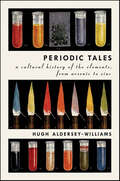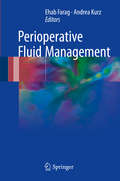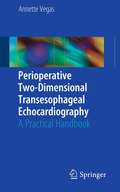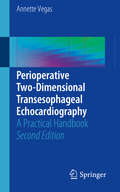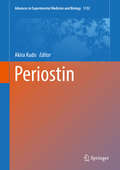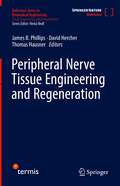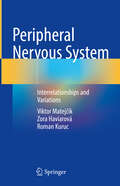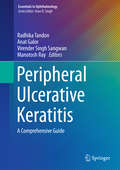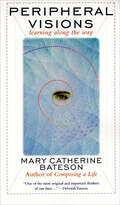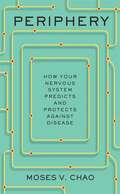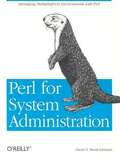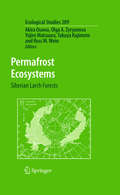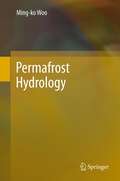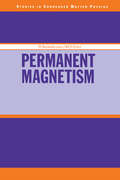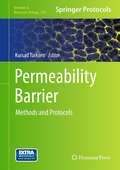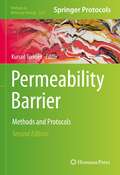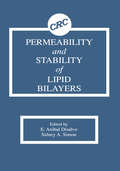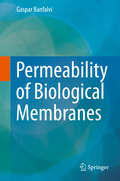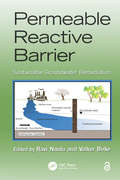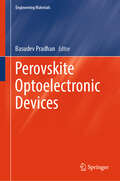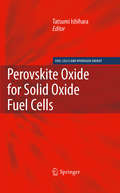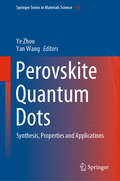- Table View
- List View
Periodic Tales: A Cultural History of the Elements, from Arsenic to Zinc
by Hugh Aldersey-WilliamsIn the spirit of A Short History of Nearly Everything comes Periodic Tales. Award-winning science writer Hugh Andersey-Williams offers readers a captivating look at the elements—and the amazing, little-known stories behind their discoveries. Periodic Tales is an energetic and wide-ranging book of innovations and innovators, of superstition and science and the myriad ways the chemical elements are woven into our culture, history, and language. It will delight readers of Genome, Einstein’s Dreams, Longitude, and The Age of Wonder.
Perioperative Fluid Management
by Ehab Farag Andrea KurzThis book presents the most recent evidence-based facts on perioperative fluid management and discusses fluid management from basic sciences to clinical applications and the patients' outcomes. Recent advances in understanding the Revised Starling principle with new concepts in tissue perfusion and the most recent techniques of perioperative goal directed fluid management are described. The endothelial glycocalyx functions and the influence of fluid management on its integrity are covered in detail; moreover, the techniques for its protection are also discussed. The dilemma of perioperative use of hydroxyethyl starch solutions and the resurgence of interest in using human albumin as an alternative colloid is explored. The problems of using unbuffered solutions during the perioperative period and comparison between restrictive versus liberal fluid management are discussed in full. Perioperative Fluid Management will be of interest to anesthesiologists and also intensivists.
Perioperative Two-Dimensional Transesophageal Echocardiography
by Annette VegasTransesophageal echocardiography (TEE) is a valuable diagnostic modality now routinely used during cardiac surgery and in the intensive care unit. Increasingly, anesthesiologists trained in TEE provide the service in both settings where they face the challenge of integrating numerous current TEE guidelines into day-to-day practice. Perioperative Two-Dimensional Transesophageal Echocardiography: A Practical Handbook has been designed to be a concise, portable guide for using TEE to recognize cardiac pathology during the perioperative period. This compact guide has a diverse appeal for anesthesiologists, cardiac surgeons, and cardiologists desiring comprehensive up-to-date echocardiographic information at their fingertips. Features More than 450 full-color, high quality clinical images and illustrationsSynopsis of cardiac pathology commonly encountered in cardiac surgery patientsConvenient spiral bindingOn-the-spot reference for echocardiographers with a wide range of experience, from novice to expert
Perioperative Two-Dimensional Transesophageal Echocardiography: A Practical Handbook
by Annette VegasTransesophageal echocardiography (TEE) is a valuable diagnostic modality now routinely used during cardiac surgery and in the intensive care unit. Increasingly, anesthesiologists, cardiologists and critical care physicians trained in TEE provide the service in both settings where they face the challenge of integrating numerous current TEE guidelines into day-to-day practice. Perioperative Two-Dimensional Transesophageal Echocardiography: A Practical Handbook, 2nd Edition has been designed to be a concise, portable guide for using TEE to recognize cardiac pathology during the perioperative period. This compact guide has a diverse appeal for anesthesiologists, cardiac surgeons and cardiologists desiring comprehensive up-to-date echocardiographic information at their fingertips.Features Updated to include 4 new chapters Now contains more than 600 full-color, high quality clinical images and illustrations Includes the most recent guidelines Retains a compact format that highlights key information Synopsis of cardiac pathology commonly encountered in cardiac surgery patients On-the-spot reference for echocardiographers with a wide range from novice to expert experience
Periostin (Advances in Experimental Medicine and Biology #1132)
by Akira KudoThis book provides a comprehensive and up-to-date review of current understanding of periostin and its importance for human health and disease. Periostin is a secretory matricellular protein that has been revealed to play key roles in fibrillogenesis and cell migration, including metastasis of cancer cells. The production of periostin is upregulated during fibrotic responses and the mechanisms by which it promotes fibrosis have become a focus of interest owing to the potential clinical benefit to be derived from periostin blockade. In this book, readers will find coverage of all aspects, from the basic properties of periostin and its function as a scaffold for assembly of extracellular proteins through to its roles in bone and tissue regeneration, tumorigenesis, myocardial infarction, inflammatory and immune system disorders, and other diseases. Readers will also find the latest information on functions of periostin related to stemness and the application of periostin as a biomarker. It is hoped that the detailed knowledge of periostin and its pathobiological significance provided in this book will aid in the search for effective treatments for currently incurable diseases.
Peripheral Nerve Sheath Tumors: From Preclinical Studies to Advanced Therapies
by Ignazio Gaspare Vetrano Vittoria NazziThis book offers an update about peripheral nerve sheath tumors (PNST), both in their benign and malignant forms (MPNST). Starting from the most innovative preclinical studies about genetic and omics characterization, it then explores the traditional and advanced imaging modalities (ultrasound, DTI, etc) and the electrophysiological assessment. Another relevant part is reserved to the description of the most recent surgical techniques (fluorescent dye for intraoperative surgical guidance, neurophysiological monitoring, esoscopic view). Finally, new oral treatment for PNST related to neurocutaneous diseases (as selumetinib in plexiform neurofibromas) is described. Written by worldwide experts in each specifical field, if offers a multidisciplinary vision to PNST, approaching the topic in a translational way, from preclinical studies to the current medical practice. The ideal readers are all health operators involved in the treatment of these tumors- from neurosurgeons to radiologists, neurologists, geneticists, biologists, etc) as well as medical students in these disciplines.
Peripheral Nerve Tissue Engineering and Regeneration (Reference Series in Biomedical Engineering)
by James B. Phillips David Hercher Thomas HausnerThis updatable book provides an accessible informative overview of the current state of the art in nerve repair research.The introduction includes history of nerve repair research and establishes key concepts and terminology and will be followed by sections that represent the main areas of interest in the field: (1) Biomaterials, (2) Therapeutic Cells, (3) Drug, Gene and Extracellular Vesicle Therapies, (4) Research Models and (5) Clinical Translation. Each section will contain 3 - 6 chapters, capturing the full breadth of relevant technology. Bringing together diverse disciplines under one overarching theme echoes the multidisciplinary approach that underpins modern tissue engineering and regenerative medicine. Each chapter will be written in an accessible manner that will facilitate interest and understanding, providing a comprehensive single reference source. The updatable nature of the work will ensure that it can evolve to accommodate future changes and new technologies. The main readership for this work will be researchers and clinicians based in academic, industrial and healthcare settings all over the world.
Peripheral Nervous System: Interrelationships and Variations
by Viktor Matejčík Zora Haviarová Roman KurucThis book comprehensively evaluates the morphological and clinical aspects of the peripheral nervous system and its involvement in various pathologies. It thoroughly describes its topography, morphology, its peculiarities - that are missing in anatomical and surgical textbooks- and their possible influence on the clinical picture. Their preoperative diagnosis is difficult, even impossible. Figures and line drawings enrich the view of structures that so far. have only been partially documented. The authors' descriptions are based on clinical observations and systematic work on the 246 human bodies of healthy people who died a sudden or violent death (most often in car accidents). Dissection is the most precise method to elucidate the range of variability, which is often largely responsible for the failure of surgical treatments. Their recognition can minimize damage to nerve structures, and the acquired knowledge can help clarify clinical signs and symptoms in surgery or internal medicine. The data presented in this publication will however be useful for traumatologists, orthopedists, spinal surgeons, neurosurgeons, plastic surgeons, as well as neurologists and neurophysiologists, and to all those who are dealing with or are interested in this field.
Peripheral Ulcerative Keratitis
by Radhika Tandon Anat Galor Virender Singh Sangwan Manotosh RayA handy manual for cornea specialists, this book provides detailed practical information about a complex, sight-threatening disease that can be challenging to diagnose and manage. This text features chapters dedicated to outlining all facets of diagnosis and management while covering both medical and surgical treatment options. Peripheral Ulcerative Keratitis, supplemented with useful references and appendices to provide simple step by step algorithms, is written by internationally renowned authors who are experts in the field. Including practical tips and guidelines for diagnosis and therapy of these disorders, Peripheral Ulcerative Keratitis is designed to serve as a guide for comprehensive ophthalmologists and should find itself on the bookshelves of ophthalmology clinics, corneal practices and training programs across the country.
Peripheral Visions: Learning Along the Way
by Mary C. BatesonMary Catherine Bateson, author of Composing a Life, is our guide on a fascinating intellectual exploration of lifetime learning from experience and encountering the unfamiliar. Peripheral Visions begins with a sacrifice in a Persian garden, moving on to a Philippine village and then to the Sinai desert, and concludes with a description of a tour bus full of Tibetan monks. Bateson's reflections bring theses narratives homes, proposing surprising new vision of our own diverse and changing society and offering us the courage to participate even as we are still learning.
Periphery: How Your Nervous System Predicts and Protects against Disease
by Moses V. ChaoA leading neuroscientist argues that the peripheral nervous system, long understood to play a key role in regulating basic bodily functions, also signals the onset of illness.The central nervous system, consisting of the brain and the spinal cord, has long been considered the command center of the body. Yet outside the central nervous system, an elaborate network of nerve cells and fibers extends throughout our bodies, transmitting messages between the brain and other organs. The peripheral nervous system, as it’s known, regulates such vital functions as heart rate, digestion, and perspiration and enables us to experience the barrage of sounds, tastes, smells, and other sensory information that surrounds us. But beyond these crucial roles, the peripheral nervous system might do even more: it might warn us of diseases in our future.As Moses Chao argues in Periphery, from Parkinson’s disease to autism to dementia, many neurological conditions emerge not in the brain but rather within the peripheral nervous system, in the dense network of nerves that wrap around the gastrointestinal tract. What’s more, dysfunctions of the peripheral nervous system can signal the onset of disease decades before symptoms like tremor or memory loss occur. Fortunately, unlike nerves in the brain and spinal cord, peripheral nerves can heal and regenerate in response to injury and aging. The therapeutic implications are remarkable. Chao shows how, with a better understanding of the peripheral nervous system, we could not only predict and treat neurological diseases long before their onset, but possibly prevent them altogether.Full of new ideas and bold interpretations of the latest data, Periphery opens exciting avenues for medical research while deepening our understanding of a crucial yet underappreciated biological system.
Perl for System Administration
by David N. Blank-EdelmanPerl for System Administrationis for anyone who needs to use Perl for administrative tasks and needs to hit the ground running.
Permafrost Ecosystems
by Akira Osawa Olga A. Zyryanova Takuya Kajimoto Yojiro Matsuura Ross W. WeinDrawing from a decade-long collaboration between Japan and Russia, this important volume presents the first major synthesis of current knowledge on the ecophysiology of the coniferous forests growing on permafrost at high latitudes. It presents ecological data for a region long inaccessible to most scientists, and raises important questions about the global carbon balance as these systems are affected by the changing climate. Making up around 20% of the entire boreal forests of the northern hemisphere, these 'permafrost forest ecosystems' are subject to particular constraints in terms of temperature, nutrient availability, and root space, creating exceptional ecosystem characteristics not known elsewhere. This authoritative text explores their diversity, structure, dynamics and physiology. It provides a comparison of these forests in relation to boreal forests elsewhere, and concludes with an assessment of the potential responses of this unique biome to climate change. The book will be invaluable to advanced students and researchers interested in boreal vegetation, forest ecology, silviculture and forest soils, as well as to researchers into climate change and the global carbon balance.
Permafrost Hydrology
by Ming-Ko WooPermafrost Hydrology systematically elucidates the roles of seasonally and perennially frozen ground on the distribution, storage and flow of water. Cold regions of the World are subject to mounting development which significantly affects the physical environment. Climate change, natural or human-induced, reinforces the impacts. Knowledge of surface and ground water processes operating in permafrost terrain is fundamental to planning, management and conservation. This book is an indispensable reference for libraries and researchers, an information source for practitioners, and a valuable text for training the next generations of cold region scientists and engineers.
Permanent Magnetism
by J.M.D CoeyOne of the first books to approach magnetism from a metal physics perspective, Permanent Magnetism presents research ideas that are being translated into commercial reality for ferrite and Nd-Fe-B magnets, and follows the discovery of interstitial, intermetallic materials. Written by well-known authors, the book contains a comprehensive yet concise treatment of the fundamental theory underlying permanent magnetism and illustrates applications with modern, permanent magnetic materials, including ceramics and intermetallic compounds. Each chapter contains worked examples to reinforce applications and the appendices include detailed mathematics and tabular data on material properties.
Permeability Barrier
by Kursad TurksenThe significant biological subject, the permeability barrier, is incredibly diverse and vital for a vast assortment of crucial functions in the body. In Permeability Barrier: Methods and Protocols, a variety of experienced researchers contribute techniques to study this complex system in its many forms. Written in the highly successful Methods in Molecular BiologyTM series format, chapters include brief introductions to their respective topics, detailed lists of the necessary materials and reagents, step-by-step, readily reproducible laboratory protocols, and key tips on troubleshooting and avoiding known pitfalls. Authoritative and practical, Permeability Barrier: Methods and Protocols serves as an ideal guide for all scientists seeking to further our understanding of this vital area of research.
Permeability Barrier: Methods and Protocols (Methods in Molecular Biology #2367)
by Kursad TurksenThis detailed edition reflects the significant new findings in the components of permeability barriers and how they work in different tissues with a collection of cutting-edge techniques. Chapters explore the formation, maintenance, regulation, and dynamics of permeability barriers in an effort to push the boundaries of the field. Written for the highly successful Methods in Molecular Biology series, chapters include introductions to their respective topics, lists of the necessary materials and reagents, step-by-step, readily reproducible laboratory protocols, and tips on troubleshooting and avoiding known pitfalls. Authoritative and up-to-date, Permeability Barrier: Methods and Protocols, Second Edition serves as an invaluable guide for both experts but novices in the stem cell field and other related areas of research.
Permeability and Stability of Lipid Bilayers
by E. Anibal Disalvo Sidney A. SimonThis book presents a comprehensive and coherent picture of how molecules diffuse across a liquid that is, on average, only two molecules thick. It begins by characterizing bilayers structurally, using X-ray diffraction, and then mechanically by measuring elastic moduli and mechanisms of failure. Emphasis is placed on the stability and mechanical properties of plant membranes that are subject to very large osmotic and thermal stresses. Using this information, the transport of molecules of increasing complexity across bilayers is analyzed.
Permeability of Biological Membranes
by Gaspar BanfalviThis book dealswith biological membranes, focuses on permeabilization and pays particularattention to reversible permeabilization to maintain the viability andphysiological conditions of the cells. Selectivepermeability of biological membranes also known as semipermeability, partialpermeability or differential permeability allows molecules to diffuse, pass bypassive and active or by other types of transport processes mediated byproteins. The firstchapter of the book deals with the composition of biological membranes,characterizes cellular membranes of prokaryotic, eukaryotic cells, membranes ofcellular organelles and the function of biological membranes. The second chapter provides an overview of bilayerpermeability, selectivity of permeabilization and cellular transportprocesses. Chapter3 overviews different cell manipulations that aim to make cells permeable whilemaintaining not only the structural but also the functional integrity of cells. The last chapter deals with applications, particularly withreversible permeabilization to study macromolecular (DNA, RNA, poly-ADP ribose)biosynthetic processes, replication, gene expression, visualization ofreplicons, intermediates of chromosome condensation, genotoxic chromatinchanges, upon treatment with heavy metals and different types of irradiation. The interdisciplinaryaspects of the book contribute to the understanding of the structure of nucleicacids, replicative intermediates, Okazaki fragments, RNA primer mechanism,subphases of replication and repair synthesis, replicons, gene expression,chromosome condensation generated a wealth of information that will attract awide readership. The natural audience engaged in DNA research, includinggenetics, cell and molecular biology, chemistry, biochemistry, medicine,pharmacy will find essential material in the book.
Permeable Reactive Barrier: Sustainable Groundwater Remediation (Advances in Trace Elements in the Environment #1)
by Ravi NaiduRemediation of groundwater is complex and often challenging. But the cost of pump and treat technology, coupled with the dismal results achieved, has paved the way for newer, better technologies to be developed. Among these techniques is permeable reactive barrier (PRB) technology, which allows groundwater to pass through a buried porous barrier that either captures the contaminants or breaks them down. And although this approach is gaining popularity, there are few references available on the subject. Until now. Permeable Reactive Barrier: Sustainable Groundwater Remediation brings together the information required to plan, design/model, and apply a successful, cost-effective, and sustainable PRB technology. With contributions from pioneers in this area, the book covers state-of-the-art information on PRB technology. It details design criteria, predictive modeling, and application to contaminants beyond petroleum hydrocarbons, including inorganics and radionuclides. The text also examines implementation stages such as the initial feasibility assessment, laboratory treatability studies (including column studies), estimation of PRB design parameters, and development of a long-term monitoring network for the performance evaluation of the barrier. It also outlines the predictive tools required for life cycle analysis and cost/performance assessment. A review of current PRB technology and its applications, this book includes case studies that exemplify the concepts discussed. It helps you determine when to recommend PRB, what information is needed from the site investigation to design it, and what regulatory validation is required.
Permutation Testing for Isotonic Inference on Association Studies in Genetics
by Livio Corain Luigi Salmaso Rosa Arboretti Dario MazzaroThe purpose of this book is to illustrate a new statistical approach to test allelic association and genotype-specific effects in the genetic study of diseases. There are some parametric and non-parametric methods available for this purpose. We deal with population-based association studies, but comparisons with other methods will also be drawn, analysing the advantages and disadvantages of each one, particularly with regard to power properties with small sample sizes. In this framework we will work out some nonparametric statistical permutation tests and likelihood-based tests to perform case-control analyses to study allelic association between marker, disease-gene and environmental factors. Permutation tests, in particular, will be extended to multivariate and more complex studies, where we deal with several genes and several alleles together. Furthermore, we show simulations under different assumptions on the genetic model and analyse real data sets by simply studying one locus with the permutation test.
Perovskite Light Emitting Diodes: Materials and Devices
by Hong MengPerovskite Light Emitting Diodes An introduction to revolutionary display technology Perovskite Light Emitting Diodes, commonly referred to as Pe-LEDs, leverage a perovskite nanocrystal core to engender a luminous and efficient diode, holding the potential to bring about a paradigm shift in the realm of display technology. In recent times, Pe-LEDs have garnered substantial industrial interest due to their intrinsic capability to exhibit a diverse array of colors with exceptional fidelity, their operation at low voltage thresholds, and their straightforward structural composition. The prospective implications for enabling cost-effective, heightened-performance flat-panel displays as well as flexible display solutions remain notably profound. Perovskite Light Emitting Diodes: Materials and Devices presents a comprehensive and insightful overview of these diodes and their multifaceted applications. Commencing with an incisive exploration of the historical trajectory of this technology, alongside a delineation of its foundational materials and intricate device architectures, this compendium provides a gateway into both contemporaneous state-of-the-art deployments and the vanguard of ongoing research endeavors directed towards charting future advancements. Perovskite Light Emitting Diodes readers will also find: Stability analysis for different Pe-LED devices, a key aspect of creating physical displays Authorship by an established expert in organic electronics Detailed discussion of perovskite preparation methods including ultrasonic, solvent heat, thermal injection, and many more Perovskite Light Emitting Diodes is ideal for materials scientists, electrical engineers, solid state chemists, solid state physicists, inorganic chemists, and any researchers or engineers working with display technology.
Perovskite Optoelectronic Devices (Engineering Materials)
by Basudev PradhanThis book delves into the practical applications of perovskite materials in optoelectronics, covering solar cells, light-emitting diodes, photodetectors, neuromorphic devices, lasers, and X-ray detectors in various forms including bulk, two-dimensional (2D), and zero-dimensional (0D). It addresses the pressing need for scalable fabrication processes, performance optimization, and stability concerns associated with perovskite-based devices. With a detailed examination of fundamental properties and challenges, this book serves as a comprehensive guide for scientists, technologists, and engineers involved in developing and optimizing perovskite-based optoelectronic devices for commercialization. Furthermore, it fills a significant gap in the literature by providing in-depth coverage of perovskite solar cells and other emerging optoelectronic technologies, making it an essential resource for researchers and practitioners in materials and device physics.
Perovskite Oxide for Solid Oxide Fuel Cells
by Tatsumi IshiharaThe continuing development of fuel cells offers promising technologies for the conversion of chemical energy from hydrocarbon fuels into electricity without forming air pollutants. Perovskite Oxides for Solid Oxide Fuel Cells provides insight into the materials aspects of one of the most promising fuel cell types available. Solid Oxide Fuel Cells (SOFCs) have significant advantages over other fuel cell types, such as high efficiency, flexibility in fuel, high reliability, simple balance of plant (BOP) and a long history. Because of these advantages, SOFC technology is attracting a great deal of attention for use in power generation and for its potential in heat generation. Perovskite oxides are widely used for different SOFC components. Detailed description of various aspects of perovskite oxides are presented in this book. Each chapter in the book is written by leading international researchers and covers topics including: General Introduction of SOFC; Perovskite fast oxide ion conductors; High temperature perovskite proton conductors; Perovskite electrode catalyst and catalysis; SOFC stack development using perovskite oxide; The effects of decreasing SOFC operating temperatures to increase reliability, durability and stability. Perovskite Oxides for Solid Oxide Fuel Cells provides comprehensive and up-to-date information on the materials, properties, and performance for SOFCs and is appropriate for researchers and engineers in the field.
Perovskite Quantum Dots: Synthesis, Properties and Applications (Springer Series in Materials Science #303)
by Yan Wang Ye ZhouThis book addresses perovskite quantum dots, discussing their unique properties, synthesis, and applications in nanoscale optoelectronic and photonic devices, as well as the challenges and possible solutions in the context of device design and the prospects for commercial applications. It particularly focuses on the luminescent properties, which differ from those of the corresponding quantum dots materials, such as multicolor emission, fluorescence narrowing, and tunable and switchable emissions from doped nanostructures. The book first describes the characterization and fabrication of perovskite quantum dots. It also provides detailed methods for analyzing the electrical and optical properties, and demonstrates promising applications of perovskite quantum dots. Furthermore, it presents a series of optoelectronic and photonic devices based on functional perovskite quantum dots, and explains the incorporation of perovskite quantum dots in semiconductor devices and their effect of the performance. It also explores the challenges related to optoelectronic devices, as well as possible strategies to promote their commercialization. As such, this book is a valuable resource for graduate students and researchers in the field of solid-state materials and electronics wanting to gain a better understanding of the characteristics of quantum dots, and the fundamental optoelectronic properties and operation mechanisms of the latest perovskite quantum dot-based devices.
